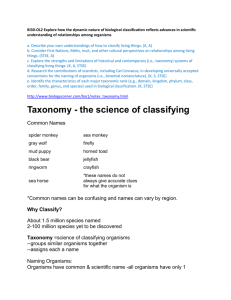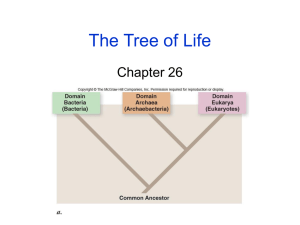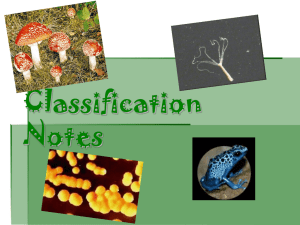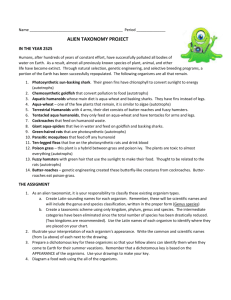Naming Organisms
advertisement
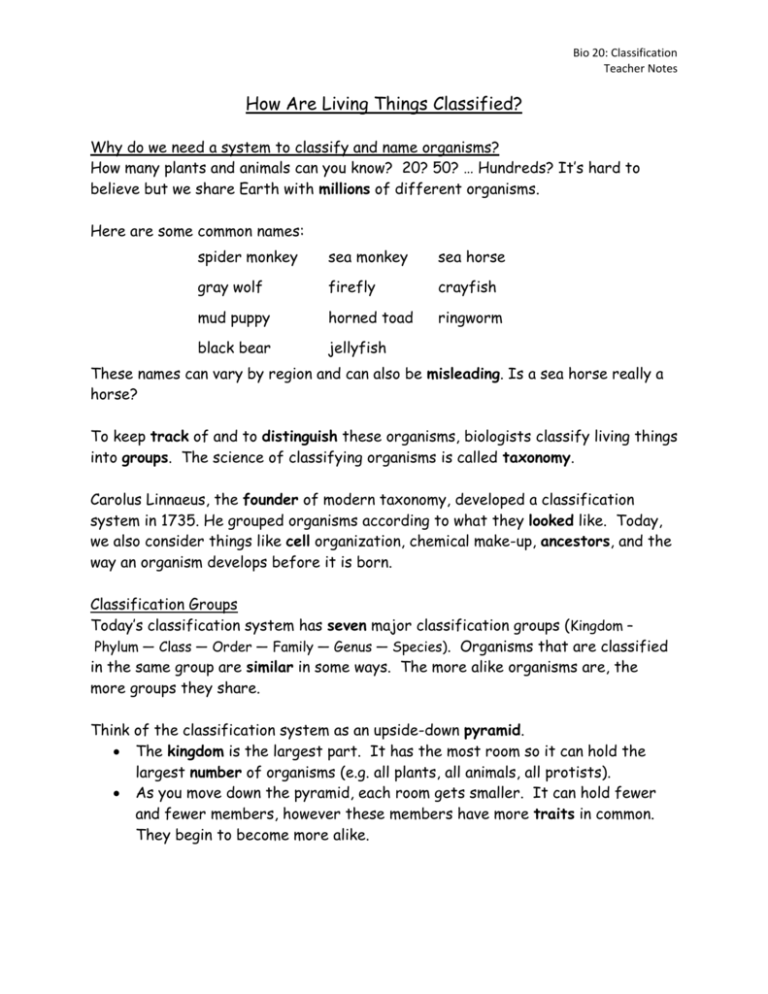
Bio 20: Classification Teacher Notes How Are Living Things Classified? Why do we need a system to classify and name organisms? How many plants and animals can you know? 20? 50? … Hundreds? It’s hard to believe but we share Earth with millions of different organisms. Here are some common names: spider monkey sea monkey sea horse gray wolf firefly crayfish mud puppy horned toad ringworm black bear jellyfish These names can vary by region and can also be misleading. Is a sea horse really a horse? To keep track of and to distinguish these organisms, biologists classify living things into groups. The science of classifying organisms is called taxonomy. Carolus Linnaeus, the founder of modern taxonomy, developed a classification system in 1735. He grouped organisms according to what they looked like. Today, we also consider things like cell organization, chemical make-up, ancestors, and the way an organism develops before it is born. Classification Groups Today’s classification system has seven major classification groups (Kingdom – Phylum — Class — Order — Family — Genus — Species). Organisms that are classified in the same group are similar in some ways. The more alike organisms are, the more groups they share. Think of the classification system as an upside-down pyramid. The kingdom is the largest part. It has the most room so it can hold the largest number of organisms (e.g. all plants, all animals, all protists). As you move down the pyramid, each room gets smaller. It can hold fewer and fewer members, however these members have more traits in common. They begin to become more alike. Bio 20: Classification Teacher Notes Here’s a saying to help you remember the order: King Philip Crossed Over For Gold and Silver which stands for : Kingdom – Phylum — Class — Order — Family — Genus — Species Naming Organisms Linneaus also devised a system for naming organisms that is still used today. This two-word naming system is called Binomial Nomenclature. In this system: Each organism is given a two-part scientific name Usually Latin or Greek -1st word is Capitalized –Genus -2nd word is lowercase —species The genus name is italicized (or underlined) Examples: Felis concolor, Ursus arctos, Homo sapiens, Panthera leo , Panthera tigris. These can also be abbreviated as (P. tigris or P. leo). Bio 20: Classification Teacher Notes Current Classification System Originally all living things on earth were classified into either the plant or animal kingdom. As the microscope improved, the classification of microorganisms became difficult. For example, was a microorganism that contained chlorophyll but also moved considered a plant or animal? Today we use six kingdoms: Eubacteria, Archaeabacteria, Protista, Fungi, Plantae, and Animalia. Organisms are classified into based on the number and types of cells they have and their nutritional needs. The Six Kingdoms Number of Cells Energy Cell Type Examples Archaebacteria unicellular some autotrophic, most chemotrophic prokaryote "extremophiles" Eubacteria unicellular autotrophic and heterotrophic prokaryote bacteria, E. coli Protista most unicellular heterotrophic or autotrophic eukaryote ameba, paramecium, algae Fungae most multicellular heterotrophic eukaryote mushrooms, yeast Plantae multicellular autotrophic eukaryote trees, grass Animalia multicellular heterotrophic eukaryote humans, insects, worms Prokaryote – without a nucleus or other membrane-bound organelles Eukaryote – contains membrane- bound nucleus and organelles Bio 20: Classification Teacher Notes Phylogeny The relationship between the six kingdoms is illustrated in a phylogenetic tree, a branching diagram that shows relationships between species from an evolutionary perspective. The term phylogeny refers to the evolution or historical development of any species. This history is established using radioactive dating of fossils and rocks and comparative biochemical studies. Example: Phylogenetic Tree of Life A phylogenetic tree is a specific type of cladogram where the branch lengths are proportional to the predicted evolutionary time between organisms. Cladograms are branched diagrams that illustrate the probability that two organisms are closely related, although it does not show how they are related. Cladograms should not be seen as evolutionary fact, but only as a possible path for speciation. Bio 20: Classification Teacher Notes Example: Cladogram for the Phylum Chordata Dichotomous Key A dichotomous key is a device that can be used to easily identify an unknown organism. The word dichotomous comes from two Greek words that together mean, "divided in two parts". A dichotomous key consists of a series of two part statements that describe characteristic of organisms. At each step of a dichotomous key the user is presented with two choices. As the user makes a choice about a particular characteristic of an organism they are led to a new branch of the key. Eventually the user will be led to the name of the organism that they are trying to identify. Bio 20: Classification Teacher Notes Example: Here are two examples of keys to show how to key out organisms, such as a kangaroo, a cow, a bee and a spider. Shown are a branching key and a numbered key. 1a. Internal skeleton 1b. No internal skeleton 2a. Pouch present 2b. Pouch absent 3a. Six legs 3b. Not six legs …………………… go to 2 …………………… go to 3 …………………… …………………… …………………… …………………… kangaroo cow bee spider

